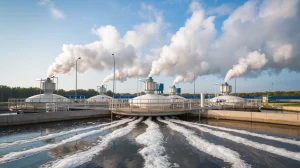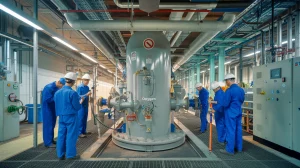Oxygen purity is a critical factor across various industries, from healthcare to industrial manufacturing. Whether you’re using an oxygen concentrator for medical purposes or ensuring the purity of oxygen gas in an industrial setting, accurately measuring oxygen purity is essential.
In the following we will explore the methods, tools, and best practices for oxygen purity measurement, ensuring that you can maintain the highest standards of quality and safety in your applications.
Understanding Oxygen Purity: What Does It Mean?
Oxygen purity refers to the percentage of oxygen in a gas mixture, free from other gases such as nitrogen, helium, or argon.
In medical applications, for instance, medical-grade oxygen requires a purity of at least 99.5% to ensure patient safety.
In industrial settings, oxygen purity can vary depending on the application, but high purity is generally required to avoid impurities that could affect processes or products.
Common Methods for Measuring Oxygen Purity
Measuring oxygen purity involves various techniques, each suited to specific applications. The most common methods include:
- Electrochemical Oxygen Analyzers: These devices measure oxygen concentration by detecting the current generated by an electrochemical reaction.
- Zirconia Oxygen Sensors: Often used in industrial settings, these sensors measure oxygen by detecting changes in the electrical conductivity of zirconium oxide at high temperatures.
- Paramagnetic Oxygen Analyzers: These analyzers use the paramagnetic properties of oxygen to measure its concentration in a gas mixture.
Each method has its strengths, depending on the required precision and the environment in which the measurements are taken.
Advanced Technology for Oxygen Purity Measurement
The continuous advancements in technology have revolutionized the way we measure oxygen purity. Modern oxygen analyzers and meters are equipped with sophisticated sensors and digital interfaces that provide highly accurate and real-time data.
These devices not only measure the concentration of oxygen but also detect impurities such as nitrogen and argon, which could compromise the quality of the gas.
Advanced features like automatic calibration, temperature compensation, and digital alarms ensure that any deviation from the desired purity levels is quickly identified and corrected, maintaining the integrity of the oxygen supply.
Using Oxygen Analyzers: Key Tools in Purity Measurement
Oxygen analyzers are essential tools for accurate oxygen purity measurements. These devices are designed to provide reliable oxygen readings, whether you’re checking purity in an oxygen generator, an oxygen concentrator, or an industrial oxygen supply. A highly reliable oxygen analyzer ensures that your oxygen supply meets the necessary purity standards, with minimal impurities.
Oxygen purity analyzers come in various forms, including portable oxygen meters, which are handy devices for on-the-go measurements, and fixed oxygen meters that are installed inline with oxygen systems for continuous monitoring.
Calibration of Oxygen Analyzers
For accurate oxygen concentration assessment, regular calibration of oxygen analyzers is crucial. Calibration involves adjusting the analyzer to ensure that its readings are accurate and reliable.
Without proper calibration, oxygen readings can drift, leading to incorrect measurements and potentially dangerous situations, especially in medical and industrial applications.
Calibration should be performed on a regular basis, following the manufacturer’s guidelines. This process often involves using a gas with a known oxygen concentration to adjust the analyzer’s output.
How to Measure Oxygen Purity in Industrial Settings
In industrial settings, oxygen purity is critical for processes like welding, cutting, and combustion.
To measure oxygen purity in these environments, an oxygen purity meter is often used. These devices can connect inline with oxygen cylinders or on-site generators to provide continuous monitoring of oxygen concentration.
One of the challenges in industrial oxygen measurement is dealing with contaminants like dust and impurities in the gas supply. Regular maintenance of the oxygen meter, including cleaning and replacing filters, is necessary to ensure accurate readings.
Additionally, monitoring the flow rate of oxygen and ensuring the correct temperature conditions can affect the accuracy of the measurements.
Choosing the Right Oxygen Analyzer for Your Needs
Selecting the appropriate oxygen analyzer is crucial for achieving reliable oxygen purity measurements.
Whether you’re in the healthcare sector requiring medical-grade oxygen or in an industrial setting where oxygen quality impacts production processes, the choice of an analyzer should be based on your specific needs.
Consider factors such as the operating environment, the required accuracy, and the ease of maintenance when making your decision.
High-quality oxygen analyzers offer flexibility, allowing for inline integration with oxygen concentrators or generators, and are designed to withstand varying conditions, ensuring consistent performance over time.
By investing in the right equipment, you can ensure that your oxygen purity remains at optimal levels, safeguarding both health and operational efficiency.
Ensuring Accurate Measurements: Best Practices
To obtain precise oxygen purity measurements, follow these best practices:
- Regular Calibration: As mentioned, regular calibration of both the analyzer and oxygen meter is essential.
- Proper Maintenance: Replace filters and other components as needed to maintain the accuracy and longevity of your oxygen analyzers.
- Monitor Environmental Conditions: Ensure that the ambient air, temperature, and humidity levels are controlled to prevent interference with the measurements.
- Use High-Quality Devices: Invest in highly reliable oxygen analyzers and meters to minimize the risk of inaccurate readings.
Understanding Purity Standards: What’s Required?
Purity standards for oxygen vary depending on the application. For medical oxygen, the purity standard is typically 99.5% or higher, as lower purity levels can pose serious health risks to patients. Industrial oxygen standards can vary, with some processes requiring ultra-high purity oxygen, while others may tolerate lower levels.
It’s important to understand the specific purity requirements for your application and use an appropriate oxygen analyzer to verify that these standards are met. Failing to meet the required purity standards can lead to compromised product quality, safety risks, and regulatory non-compliance.
Challenges in Measuring Oxygen Purity
Several challenges can arise when measuring oxygen purity:
- Contamination: Dust, moisture, and other impurities in the gas can skew oxygen readings. Using a device with built-in filters and ensuring a clean gas supply can mitigate this issue.
- Temperature Fluctuations: Temperature changes can affect the sensor’s accuracy. An oxygen purity meter with temperature compensation features can help maintain accurate readings.
- Flow Rate Variability: Inconsistent flow rates can lead to inaccurate measurements. Monitoring and controlling the flow rate is essential, especially in processes that require precise oxygen concentration.
Conclusion: The Importance of Reliable Oxygen Concentration Assessment
Accurate oxygen concentration assessment is crucial for ensuring safety, product quality, and regulatory compliance across various industries. Whether you’re working with medical oxygen, industrial oxygen, or using an oxygen concentrator, having the right tools and following best practices is essential.
Investing in high-quality oxygen analyzers, maintaining them on a regular basis, and understanding the specific purity standards for your application will help you achieve consistent, reliable oxygen purity measurements.
Remember, the key to successful oxygen concentration assessment lies in using the right tools, such as oxygen meters and analyzers, and adhering to a strict maintenance and calibration schedule.
With the proper approach, you can ensure that your oxygen supply is pure, safe, and effective for its intended use.
Why Choose Berg Gasetech?
At Berg Gasetech, we are dedicated to providing top-of-the-line solutions for oxygen production assessment across various industries.
Our products are designed with precision, reliability, and ease of use in mind, ensuring you get accurate and consistent oxygen purity readings. With a focus on innovation, we offer advanced oxygen analyzers and meters that cater to both medical and industrial applications.
Our devices are engineered to perform under the most demanding conditions, delivering trustworthy results with every use. We understand that each industry has unique requirements, and our products are tailored to meet those specific needs.
Choosing Berg Gasetech means partnering with a company committed to quality, customer satisfaction, and cutting-edge technology. We offer not only top-tier products but also unparalleled customer support, ensuring that your equipment continues to operate at peak performance throughout its lifespan.
Our commitment to excellence means that you can trust us to help you maintain the highest standards of oxygen purity, safeguarding the health and efficiency of your operations. Whether you need solutions for healthcare, manufacturing, or any other application, Berg Gasetech is your reliable partner in oxygen concentration assessment.



